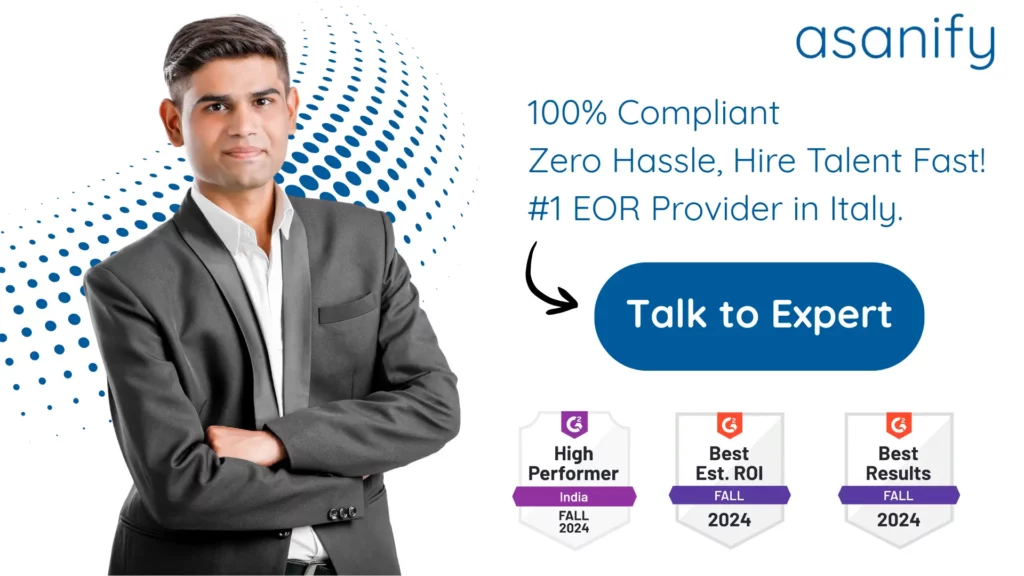Expanding your business into Italy provides access to one of Europe’s most culturally rich and strategically located economies. However, before hiring in Italy, employers must understand the country’s work authorization process. Securing the correct work permit and visa in Italy for non-Italian employees is essential to staying compliant with immigration laws and ensuring a smooth onboarding experience.
Navigating these requirements can be challenging, as they depend on the employee’s nationality, occupation, and length of stay. Employers must ensure all documentation is completed accurately and submitted on time. Partnering with specialists or an Employer of Record (EOR) can simplify the process, reduce administrative burdens, and minimize compliance risks.
Table of Contents
- Overview of Italy’s Work Permit and Visa System
- Understanding Requirements and Eligibility
- Who Needs a Work Permit in Italy
- Key Conditions for Obtaining a Work Visa
- Employer and Employee Eligibility
- Types of Work Visas and Permits in Italy
- Advantages of the EU Blue Card
- Application Process for Employers
- Processing Timelines
- Employer Responsibilities and Compliance
- Tips for a Smooth Application Process
- How an Employer of Record Can Help
- How Asanify Can Help
- FAQs
Overview of Italy’s Work Permit and Visa System
Italy has a regulated framework for foreign employment, which differs depending on nationality and job type. While EU/EEA and Swiss citizens enjoy free movement rights, non-EU nationals must obtain a formal work permit (Nulla Osta) and a visa before they can begin employment.
- EU/EEA/Swiss citizens – No work permit required under EU freedom of movement rules.
- Non-EU nationals – Must secure a work permit and long-stay visa before starting work.
- Quota system (Decreto Flussi) – Annual immigration quotas limit the number of non-EU workers admitted, except for some highly skilled categories.
- Employer-driven process – The employer applies for the work permit on the employee’s behalf.
- Two-step process – First obtain a work permit (Nulla Osta), then apply for the visa and residence permit.
Understanding Requirements and Eligibility
Before initiating the process, employers and employees must understand Italy’s work permit rules. Generally, non-EU nationals need a Nulla Osta work authorization and a corresponding visa to work in Italy. Requirements vary by job category, skill level, and whether the position falls under Italy’s immigration quotas.
- Quota-based vs. quota-exempt roles – Many permits are issued under the annual Decreto Flussi quota system, but certain highly skilled positions, EU Blue Card applicants, and intra-company transfers are exempt.
- Employer sponsorship requirement – A valid Italian employer must initiate the work permit application (Nulla Osta) before the employee can apply for a visa.
- Recognition of qualifications – Regulated professions may require formal recognition of foreign qualifications in Italy before a permit can be granted.
- Residence permit requirement – After entering Italy with a work visa, employees must apply for a Permesso di Soggiorno within eight days to legally live and work in the country.
- Region-specific procedures – While national laws guide the process, local immigration offices (Sportello Unico per l’Immigrazione) may have procedural variations and different processing times.

Who Needs a Work Permit in Italy
Most non-EEA and non-Swiss nationals must obtain a work permit before employment. EU/EEA and Swiss citizens are exempt under free movement agreements. Employers hiring non-EU nationals must complete the process before the employee can enter and work in Italy.
- Work permit before entry – Non-EU nationals must have their Nulla Osta approved before applying for a visa and entering Italy.
- Visa application at Italian consulate – Once the work permit is issued, the employee applies for the appropriate visa in their home country.
- Residence permit on arrival – After entering Italy, the employee must apply for a Permesso di Soggiorno within eight days.
- Exempt categories – Certain highly skilled workers, intra-company transferees, and researchers may have simplified or expedited processes.
- Employer responsibility – The hiring company must initiate the application and ensure compliance with all procedural steps.
Suggested Read: Comprehensive Guide to Employee Tax Optimization in Italy
Key Conditions for Obtaining a Work Visa
Applicants for an Italian work visa generally must:
- Have a valid job offer from an Italian employer.
- Provide proof of relevant qualifications or professional experience.
- Show evidence of adequate accommodation in Italy.
- Have valid health insurance coverage.
- Maintain a clean criminal record.
Employer and Employee Eligibility
For most non-quota work permits, employers may need to show that the position cannot be filled by an Italian or EU candidate. Employees must meet specific qualifications and, in some cases, minimum salary thresholds set by Italian labor regulations.
- Labor market test requirement – For certain roles, employers must provide proof of unsuccessful recruitment efforts within Italy and the EU before hiring a non-EU national.
- Salary threshold compliance – Minimum salary levels differ by job category and may be higher for highly skilled positions like the EU Blue Card.
- Proof of relevant experience – In addition to formal qualifications, work experience in the field may be required.
- Sector-specific eligibility – Certain industries, such as healthcare, IT, and engineering, may have tailored eligibility criteria or faster processing.
- Contract compliance – Employment contracts must meet Italian labor law standards regarding working hours, benefits, and social security contributions.
Types of Work Visas and Permits in Italy
Italy offers several categories of work authorization depending on the role and circumstances:
- Nulla Osta + National (Type D) Visa – Standard route for most employment situations.
- EU Blue Card – For highly qualified workers who meet education and salary thresholds, offering faster processing and EU mobility.
- Intra-Company Transfer Permit – For managers and specialists relocating within a multinational company.
- Seasonal Work Permit – For roles in agriculture and tourism within quota limits.
- Freelance/Independent Work Visa – For self-employed professionals meeting economic and qualification requirements.
Comparing Work Permit Types
| Permit Type | Purpose | Duration | Notes |
| Nulla Osta + Type D Visa | General employment | 1–2 years | Subject to quotas unless exempt |
| EU Blue Card | Highly skilled professionals | Up to 2 years | Salary threshold applies, quicker processing |
| Intra-Company Transfer Permit | Company transfers | 1–3 years | For managers and specialists |
| Seasonal Work Permit | Agriculture/tourism roles | Up to 9 months | Quota-based |
| Freelance/Independent Work Visa | Self-employment | Variable | Strict financial proof required |

Advantages of the EU Blue Card
The EU Blue Card offers benefits such as faster processing, the ability to change employers after a certain period, and simplified family reunification. Holders can also move to other EU member states after meeting residency requirements. Additionally, it provides a pathway to long-term EU residency and facilitates the recognition of qualifications across the EU.
Key Benefits of the EU Blue Card:
- Faster application processing than standard permits.
- Freedom to change employers after the initial restriction period.
- Easier family reunification, with work rights for family members.
- Mobility within the EU for work opportunities.
- Eligibility for permanent residency after five years in the EU.
- Recognition of professional qualifications across EU states.
Application Process for Employers
The process starts when an employer offers a job to a foreign candidate. The employer applies for a Nulla Osta work permit through the local immigration office (Sportello Unico per l’Immigrazione). After approval, the employee applies for a Type D Visa at the Italian consulate in their home country. Upon arrival in Italy, they must apply for a residence permit (Permesso di Soggiorno) within eight days.
Required Documents
Common requirements include:
- Signed employment contract.
- Copy of the employee’s passport.
- Proof of qualifications and relevant experience.
- Nulla Osta approval from the immigration office.
- Proof of accommodation in Italy.
- Health insurance documentation.
Processing Timelines
Work permit processing in Italy generally takes 2–4 months, depending on the type of permit, quota availability, and the completeness of the application.
Processing times can vary based on:
- Applicant’s nationality and job category.
- Quota status under Decreto Flussi.
- Accuracy and completeness of submitted documents.
- Regional workload at immigration offices.
Tips to avoid delays:
- Submit fully completed and verified applications.
- Align application timing with quota release periods.
- Use an EOR or immigration consultant to ensure accurate documentation.
Employer Responsibilities and Compliance
Employers hiring foreign nationals in Italy must:
- Provide contracts compliant with Italian labor law.
- Pay salaries that meet or exceed legal minimums.
- Maintain accurate employment records.
- Ensure permits are renewed before expiry.
Consequences of Non-Compliance
- Fines and penalties.
- Legal sanctions or criminal charges.
- Restrictions on hiring non-EU workers in the future.
Maintaining Ongoing Compliance
- Track work permit and visa expiry dates.
- Conduct internal HR compliance audits.
- Keep updated with changes to Italian immigration and labor laws.

Tips for a Smooth Application Process
Successfully navigating Italy’s work permit process requires careful planning and attention to detail. Employers and employees who prepare in advance can avoid delays, especially during busy quota release periods. Following these best practices will help ensure a smoother approval process:
- Start early, especially during quota-based application periods.
- Double-check all documentation before submission.
- Understand quota and non-quota routes.
- Consider EOR services for hassle-free hiring.
How an Employer of Record Can Help
An Employer of Record in Italy allows companies to hire foreign talent without setting up an Italian entity. The EOR becomes the legal employer, handling payroll, benefits, compliance, and immigration requirements. This ensures full legal compliance while enabling rapid market entry.
An EOR also prepares employee contracts in line with Italian labor standards, manages tax and social security obligations, and stays up to date on regulatory changes—helping companies avoid legal pitfalls.
Suggested Read: A Detailed Guide on Employer of Record Italy 2025
How Asanify Can Help
Navigating Italy’s work authorization process can be complex, especially for international hires. Asanify’s Employer of Record (EOR) solution manages the entire employment lifecycle—from obtaining the right permits to managing payroll and benefits—ensuring compliance without the need to establish a local entity.
With Asanify, you can:
- Hire and onboard talent quickly without administrative delays.
- Stay compliant with all Italian labor laws.
- Expand into Italy without the cost and complexity of creating a local company.
If you aim to grow your team in Italy efficiently, Asanify’s expertise and end-to-end services make the process seamless.
FAQs
Usually 1–2 years, with possible renewals.
Typically €100–€200, excluding legal or consultancy fees.
Yes, but they still require the appropriate visa and residence permit.
A permit for highly skilled non-EU workers meeting education and salary criteria.
No, it grants work authorization, but a separate residence permit is required.
No, some highly skilled roles are exempt from quotas.
On average, 2–3 months.
Yes, under family reunification provisions.
The employee must stop working immediately; renewal must be requested before expiry.
To manage compliance, payroll, and immigration seamlessly without establishing a local entity.
Not to be considered as tax, legal, financial or HR advice. Regulations change over time so please consult a lawyer, accountant or Labour Law expert for specific guidance.

